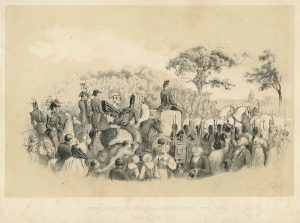Princess Lovisa arrives in Stockholm 15 June 1850
“In February 1850, I returned to Stockholm in the company of Mother and Lejdenfrost.
I was forbidden to dance, and when I did not spend my evenings with Ekström or the Bohemans, which was often the case, one could be sure to find me at some concert at de la Croix Salon or in a lodge at the Grand Opera House.
In the spring, the Bohemans came down to the Kirsteinska Garden in the afternoons with their work. I was usually the lecturer, but often we were interrupted during our lectures by the Royal Secretaries Seippel and Strokirk, nicknamed The Inseparables. We then passed the evenings quite merrily in conversation and laughter.
After having been completely drenched at Biskopsudden on the 15th of June and viewed all the finery at the engagement ceremonies, I accompanied the Bohemans and Hildegard to the steamer Linköping on a chilly, rainy morning on which they departed for Anneberg. I took a sad farewell of them and, afterwards, prepared myself for my own departure from the capital.”
The engagement and subsequent marriage of Crown Prince Charles (the future King Charles XV) and Princess Louise (Lovisa) of the Netherlands must have been the social event of the year. Princess Louise and her family arrived at Biskopsudden in Stockholm by the steamship Gefle on 15 June 1850. The major newspaper, Post- och Inrikes Tidningar, reported that even before noon, a large number of Stockholm’s inhabitants had gone to the landing site and to other areas through which the royal highness would pass on her way to Haga Palace.
And among those was Augusta. Yet, in the diary, there is only one sentence about the occasion, and it only describes how she got drenched and no other details. There is not even a mention of the 12-carriage cortège making its way to Haga. Nothing about the sounds of canons and of people cheering. How did she get to Biskopsudden, who accompanied her, and how was she dressed for the occasion?
Fortunately, there were 3 lithographs made of the occasion: the arrival of the princess (the feature picture above), the cortège with the prince riding next to the carriage with the princess, and the arrival of the princess at the royal palace in Stockholm for the wedding on 19 June 1850 (all by A. Weidel).

The Royal Family’s cortège from Biskopsudden to Haga the 15th of June 1850 (Lithograph by A. Weidel)

Karl XV and Lovisa’s arrival at the Royal Palace the 19th of June 1850 (Lithograph by A. Weidel)
Footnotes and Sources
Ekström and Bohemans:
Carl Henrik Boheman (1796-1868) was a Swedish professor of entomology. He had five children (age in 1850): Hildegard (24), Hildur Linnea (21), Carl Hjalmar (16), Ernst Henrik Georg (14), and Carl Rudolf Helmer (3). The family resided in Adolf Fredrik’s parish but also had an estate, Anneberg, located in Gränna community and on the northeast shore of Lake Ören. The estate is still in the family.
In 1850, Hildegard Boheman was already married to Carl Henrik Rudolf Ekström who later became a province governor. By the time of this diary entry, they had 3 children: Carl Henric Hjalmar (b. 12 Oct 1847), Anna Karolina Amelie (b. 16 Oct 1848), and Hildegard Sofia Christina (b. 14 Dec 1849).
Kirsteinska Garden (Kirsteinska Trädgården):
The garden was located in front of what is now the Central Train Station in Stockholm. It was popular among young people and provided outdoor concerts and other events.
Seippel and Strokirk:
Augusta misspelled Seippel as Zeipel in her diaries. In published records, Seipel (with one p) is also used although the correct spelling was Seippel. Otto Wilhelm Seippel (1820-1899) was 29 years old at time of the diary entry. He later had the title of “kansliråd” and married Christina Maria Svensson. One son, Otto Bernhard Seippel (born 04 June 1854) , is listed in the taxation records.
Wilhelm Theodor Strokirk (1823-1895) was 27 years old in 1850. He appears in several places in Augusta’s diary as does his future father-in-law.

[…] 15 juni hade blivande kronprinsessan Lovisa från Nederländerna med familj anlänt till Stockholm. (Sara har skrivit om det) Kronprinsbröllopet gick av stapeln den 19 juni (och kronprinsessans klänning är bland de […]